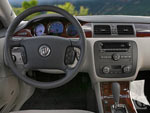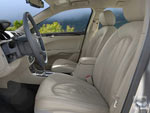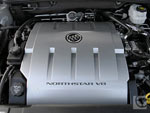 Everyone thinks General Motors has too many cars for too many brands, and everyone is right. Moreover, cars like this one have fallen out of favor - mostly because those who want to go bigger also go taller, heavier, and truckier - but if there's still a place in our landscape for whopper sedans, you've got to admit that Buick is a fitting place for one to go.
Everyone thinks General Motors has too many cars for too many brands, and everyone is right. Moreover, cars like this one have fallen out of favor - mostly because those who want to go bigger also go taller, heavier, and truckier - but if there's still a place in our landscape for whopper sedans, you've got to admit that Buick is a fitting place for one to go.GM is improving the case for its stay. In a move that helped everybody, they dropped its Pontiac Bonneville brother, reducing this "G-body" platform of cars (first set in motion by the Oldsmobile Aurora) to a more manageable two-member family, the more expensive being the new Cadillac DTS. Buick finds further favor in the decision to consolidate the former LeSabre and Park Avenue into a new sedan called Lucerne, which, if you shop at Safeway, might lead you to conclude that this new Buick is as safe as milk.
It should at least go down easy. Buick's average buyer - now 68 - doesn't like surprises, and he will find lots of familiar parts to go along with the proven platform, such as the 3800 V6 engine, 4-speed automatic transmission, most of the dimensions, and restrained styling. But several things elevate this beyond a simple rehash-and-rename job.
Road Test

In an effort to bring youth, class, and performance to the brand all at once, Buick ransacked Cadillac for their 32-valve Northstar V8. It's not the high-output Northstar but a Northstar nonetheless, and its competitive 275 horses flow gracefully through the Lucerne's front wheels. Its acceleration curve is pretty flat, responding evenly at most speeds while emitting classy car noises. The 295 pounds-feet of torque proves to be more than the front wheels can handle if used all at once, but use them judiciously and this V8 sweeps the Lucerne down the road with smooth, silent ease.
Those traits are supposed to signify Buick behavior in general, and tradition lives on in the Lucerne. Find any interstate, point it in the straight-ahead position, set the cruise control, and keep one hand at six-o'clock. Ahh, that absorbent ride, the near-absence of noise... so relaxing. The Lucerne is also free of old cruiser habits like a wandering front end that needs frequent corrections or steering that ignores them. The steering is as good as any in the class, the acceleration better than most, the slightly squashy brakes respond fine without causing undue nosedive, and GM's automatic shifts as smoothly as ever. The miles just fly by in the Lucerne, quickly and quietly.
Not content to let its flagship remain a gas-powered couch, Buick sharpened its senses for more demanding work. As one moves up in the Lucerne line, the suspension gets harder, the wheels bigger, and the steering faster. Our top-of-the-line CXS had the 18-inch wheels (biggest of three), "sport-tuned suspension" (hardest of three), and the faster steering ratio and bigger front brakes shared by all V8 models.
Buick's interpretation of "sport-tuned" is of course measured on a different scale. The 245/50R18 tires provide enough stick to hold on to the Lucerne's prodigious mass, but chucking it into a fast left still has it leaning farther to the right than Dubya. The 44-foot turning circle (ya can't cram a 4.6 into a front-driver without consequences) is unwieldy for a car of any size, and throwing in a little panic braking mid-corner has the Lucerne see-sawing around its axis unsteadily. But no one drives their own Buicks this way, do they?
Under some conditions, the Lucerne's ride could also use further refining. Small and sharp ridges get swallowed like they don't exist, but even with the CXS's Magnetic Ride Control (which uses magnetically-charged particles to more readily alter the oil viscosity in the shock absorbers), higher-amplitude lumps bring back that old-time Buick buoyancy, indicating a suspension with more softness than skill. Somewhat alarming is how driving down certain hills can suddenly plunge the fuel gauge reading from 3/4ths of a tank to ZERO, setting off the Low Fuel alarm before bouncing back five seconds later, as if nothing happened.
The real shocker is the Lucerne's response time. Because its steering wheel turns just 2.4 times from one end to the other - Buick wheels used to turn nearly as far in one direction - the Lucerne jumps to a new heading with a flick of a finger. Is faster better? It can be, though the idea of fitting a softly-sprung 4,013-pound giant with a faster steering ratio than a Ferrari F430 invites the question: who let the Pontiac engineers in here?
And what of technology? I can't name another $35,000 sedan that still limps by with a 4-speed automatic transmission; the gaps in the Lucerne's power curve are pronounced by today's standards. Dip into the sub-$30,000 end of the Lucerne range also brings to light the hoarse all-iron 3.8-liter V6 that pre-dates this car by about four decades and has no more than 197 horsepower to show for it. The LaCrosse's 3.6-liter DOHC V6 would make a far more suitable base engine.
Stick with the Northstar and the more straightforward streets and the Lucerne leaves a lot to like. Comfort, competence, and smoothness are the watchwords 90% of the time. But awarding the engineering side with a more consistent mission and a bigger budget wouldn't hurt.
Inside & Out

It wasn't easy to meet the multiple goals of looking like a Buick, looking different than both the LeSabre and Park Avenue, while avoiding the Avalon's gaudiness and the Five Hundred's blandness, all at once. Can we call the styling a success? As a throwback to Buick's glory days, the Lucerne has portholes right above the front fenders - three on each side for V6 models, four on V8s. No, they don't do anything.
The interior designers didn't do too shabbily either. The formless shapes of the various dashboard items leave some to be desired, but the controls work well. A few items were intentionally carried over, like the dash-mounted headlight knob. A couple points are barely acceptable, like the wide-and-shallow cupholders and a soggy transmission shift lever that must be manhandled through a maze. All $35,000 cars should have telescoping steering wheels, but none is here. Otherwise, most controls maintain GM's march toward the Japanese way (and occasionally the German way - the turn signals now do triple blinks with one nudge).
Crisp, attractive gauges should be legible to those with less than 20/20 vision, and all trip computer functions (instant and average MPG, average MPH, range, and two odometers) are housed in the center pod, unlike some GM cars that stash it in the radio. One side of the steering wheel is given to the cruise controls, the other side to audio (pay attention, Ford), as it should be. Storage space is generous. The Lucerne has one of the more accessible dual-zone automatic climate systems, which team up with the rapid response heated-and-cooled front seats to comfort you like royalty. The vents also let fresh air leak in naturally unlike most American cars, and the soothing shade of aqua was a nice choice for nighttime decoration. Cool bonus: side-mirror turn signal repeaters have found their way from GM's big trucks into this Lucerne.
The doors and their new-style handles open and slam with quality, and don't fall back on you on an incline. Some buttons, plastics, and compartments are a tad cheap while cloth covers the sides of the "leather" seats, but the wood isn't too bogus and the leather on top of the seats is nice and soft. The Lucerne also has rain-sensing wipers with heated washer fluid, a segment first. Another first is a dual-depth (vs. simply dual-force) air bag for the front passenger that deploys to one of two sizes depending on crash severity.
Buick really stepped it up in the tunes department, at least on the options sheet. Every Lucerne comes with CD and an Aux jack for portable players, and all but the lowest model get RDS (displays FM song titles) and MP3 playback. Optional on all is the 6-disc in-dash changer upgrade. GM seems to pick its myriad speaker suppliers from out of a hat; luckily, this Lucerne got a lucky draw, as its Harman-Kardons sound full and deep enough to breathe new life into even the most overplayed Top 40 drek. There are few experiences more pleasurable than cruising down a freeway in a quiet, easy-riding car with your favorite song filling the cabin in hi-fi. (One problem: the MP3 CD player loses its place every time you turn it off. What's the point of holding 190 songs if you have to spend all day pressing the "Skip" button?)
Of course, the real strength of any big sedan should be its seats. Buick's haven't had the best rep, partly because of mushiness, but the ones here are about as firm as any other modern car's. Just as importantly, the seatbelts no longer tug down on shoulders (as in the LeSabre) since they've been moved to the pillars where they belong. I was pretty satisfied with the seats until I took the Lucerne for a five-hour cruise and started feeling slight back pain about four hours in.
Comfort is almost guaranteed in the back seat of any Large Car, and the Lucerne's is indeed roomy and of an agreeable height. The space would be better utilized if feet could more comfortably fit under the front seats, though.
Moreover, outboard passengers' fixed head restraints might not be high or hard enough to protect everyone, and the center passenger gets none at all. Some will like the cushion's extreme softness, others won't.
More could be done with the trunk as well, namely replacing those cheap, space-eating sickle hinges with some struts. But it's a roomy and tall box that can easily swallow five men's golf bags (more, with use of the pass-through porthole), and one press of the keyless fob pops it wide open.
Other Thoughts

The Lucerne's highest model stands a good $9,000 above its lowest - one of the wider ranges in passenger sedans. Let's see what it picks up along the way.
The first of four is the Lucerne CX, which at $25,990 is pretty packed in most ways - power everything, ABS and all-speed traction control, six air bags, etc. - but lacks minor things like dual-zone air conditioning, auto-dimming rearview mirror, MP3 playback, leather steering wheel, universal remote, lighted vanity mirrors, and power seat; it's also the only one with cloth seats.
$2,000 more buys the $27,990 CXL to fill in those blanks while upgrading to 17-inch wheels and the "Ride and Handling" suspension.
Another $2,000 buys the $29,990 CXL V8 with the Northstar engine, which includes the "sport" suspension, dual exhaust, magnetic steering with a faster ratio, and a rearview mirror-embedded compass.
The final $5,000 buys the V8-only CXS, way up at $34,990. It gets memory settings for the seat, mirrors, audio, and climate controls, heated seats, a sport steering wheel, side mirror turn signals, 18-inch wheels, Magnetic Ride Control, and StabiliTrak stability control.
Key options include a Remote Vehicle Starter System (to heat/cool the car before entering), Rear Parking Assist, CD changer, 280-watt 9-speaker Harman-Kardon stereo, XM radio, navigation, sunroof, heated and cooled seats, and a front bench seat for six-human capacity.
The big Buick always had two longtime rivals, one nearby (Ford Five Hundred) and one from overseas (Toyota Avalon). Conveniently, Ford's entry is the low-priced, low-powered one and Toyota took the fast, expensive approach, leaving Buick as the one to take on both.
As for why it takes an expensive Lucerne to match the Avalon, the reason is engines.
Toyota's pulling 268 horses out of that V6, leading the class in acceleration with 0-60 in six seconds flat, and the Lucerne needs the 275 horses from its vastly bigger Northstar just to (almost) keep up. Unfortunately, that makes the Lucerne's the group's gas guzzler (just 20 MPG even with majority highway time), and its extra 400 pounds make it the fatboy as well. Nor does it have the Avalon's driving finesse or better-designed seats, and the quality record of the LeSabre and Park Avenue were not reassuring. (The reliable Buick is the Canada-built LaCrosse.) With no price advantage, what's the incentive here?
At the value leader end, the Five Hundred is a car with a similar on-road personality. The Buick's got the better interior design, but the Five Hundred makes up for it with its even-more-vast back seat and trunk.
Its 23 grand starting price beats the Lucerne's by three big ones, and it's hard to match the Ford's (or the Toyota's) four-aces-in-the-hole score on NHTSA crash tests, even though the Lucerne tested well. The only distinction the Lucerne took away from the Five Hundred is being the new slowest car in the class. Congratulations.
And then came Hyundai. Heard of its new Azera? Another EPA Large car, 263 horses, good suspension and stereo, industry-leading warranty, 25 grand to start and can't top 30. Check back for a full report in a few weeks.
Buick's new 4-year bumper-to-bumper warranty and standard OnStar system (as of March) give it a leg-up on Toyota and Ford, but otherwise the Lucerne failed to exceed the standards set by this segment's last round of redesigns.
Last Words
The ones most likely to be drawn to the Lucerne fold are Buick loyalists, who are primarily interested in an improved version of the big, comfy cruiser they've always known and have plenty of 401K cash to burn on the steep sticker and V8 gas bills. That says the Lucerne has a definite customer base. It doesn't say much for its future. [source : automotive.com]
Post a Comment